Japan's most prestigious matcha

 marcin jucha/Alamy
marcin jucha/AlamyMatcha is booming across the globe, but only a select group will ever get to taste Japan’s purest, ceremonial-grade form of the tea, grown in Uji, near Kyoto, for centuries.
 Hiromi Tanoue
Hiromi TanoueTea has been integral to Japanese culture for nearly 1,000 years, brought over from China as early as the 8th Century for the elite royal and religious classes to enjoy.
But it wasn’t until the 12th Century that it took off in earnest, thanks to Buddhist monk Eisai – considered the founder of Japanese green tea – who planted tea plants from China around monasteries and published a book on its medicinal benefits. Eisai was also responsible for bringing the Rinzai school of Zen Buddhism to Japan; his integration of the zen spirit with the preparation of tea laid the groundwork for the traditional Japanese tea ceremony.
Today, tea remains an important part of everyday life for Japanese people, often sipped in the morning or on an afternoon break, served to guests, or used to give a boost when feeling unwell. There’s a strong belief in tea’s curative properties and its ability to bring good health.
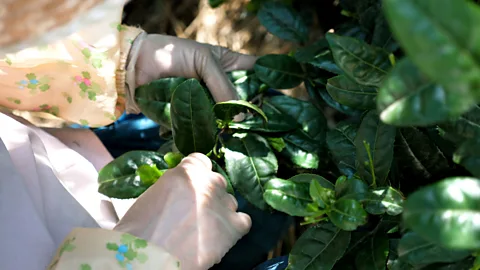 Hiromi Tanoue
Hiromi TanoueTea farms began cropping up in Uji, a region near Kyoto, around 800 years ago after locals discovered it to be the perfect spot for growing and cultivating the Camellia sinensis plant. The surrounding mountains allow for a milder climate and for mist to reach the tea leaves, and the evaporation from the nearby Uji River contributes to keeping them moist.
In the early days, growers noticed that the yield from the surrounding forest-filled areas was a higher quality with a stronger flavour, concluding that it was due to trees naturally shading the tea plants. So, producers in Uji, following that theory, constructed wooden structures over tea bushes and placed rows of straw on top to block out the sunlight. With that shading method, matcha – specially grown green tea leaves that are ultimately ground into a fine powder – was born.
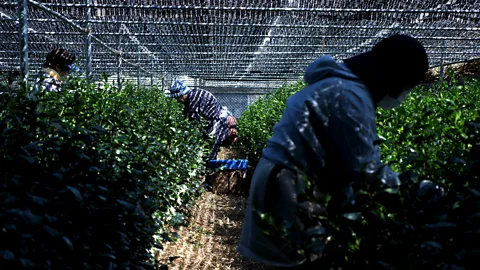 Hiromi Tanoue
Hiromi TanoueThe shading invention quickly became the preferred way to grow tea in Uji in the 15th and 16th centuries, allowing farmers to better control the amount of sunlight shining on the tea bushes. People loved the resulting bold yet smooth taste so much that the shogun at the time issued a decree declaring the Uji region the only area allowed to use the method.
Today, some farms in Uji still use the traditional bamboo-and-straw practice, while others employ a modern pulley system using nylon coverings. Through trial and error, farmers have come up the best timeline for shading, which varies by farm. Anywhere from 10 to 40 days before harvest, they will block roughly 20%-80% of light for several weeks before finally blocking out 95-97% closer to harvest. Deciding when to put up the first and second coverings is down to the farmer, after monitoring and evaluating the plants.

Matcha is hugely popular in the West right now. But in Japan, a traditional cup of matcha isn’t an everyday drink at home. It’s generally reserved for ceremonial or special occasions, while sencha (green tea that infuses leaves into hot water) is typically the tea of choice for daily drinking.
Both matcha and sencha are derived from dried green tea leaves, but the difference is in how they’re grown and prepared. Sencha comes from tea leaves that have been grown in full sun, steamed after harvest, then shaped into thin rolls and dried; while matcha is the product of a careful shading process where the full leaves are later finely ground into a powder. In of preparation, sencha steeps the whole leaves in water while the matcha powder is mixed directly with water to leave more of the nutrients.
Matcha is used in the historically and culturally important Japanese tea ceremony, a multi-hour event rooted in embracing a zen state and being present in the moment. Traditionally, the ceremony takes places in a tea room with a traditional straw tatami floor surrounded by a garden, using intricate ceramics, and includes a kaiseki (an intricate, multi-course meal), a bowl of matcha and a Japanese sweet. The host, who often trains for years, conducts a series of exact choreographed gestures and movements to serve the tea.
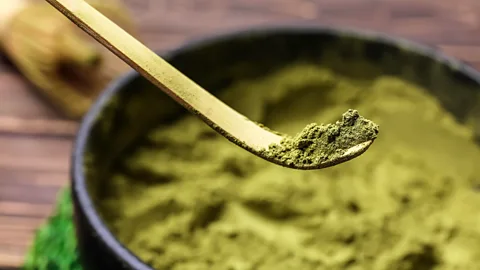 Pixel-shot/Alamy
Pixel-shot/AlamyThe farmers growing matcha in Uji are a small, elite community producing the highest-quality form of the tea in the country – and, according to many, the world. The farms are often very small, so the ceremonial-grade tea made here is extremely rare. In fact, most people outside Japan will never taste the quality of the matcha grown here, which is far above what you’d find in a Western cafe.
The oldest matcha farm believed to exist in Japan is Horii Shichimeien, run by Chotaro Horii, a sixth-generation farmer. The small farm, comprised of about 2,000 trees, is sandwiched in a residential neighbourhood in Uji. Horii spends his days monitoring and caring for his plants, which produce some of the most sacred tea in the country – especially what is made from the farm’s original, 600-year-old tea trees still producing today.
“These are the two plants left from the very beginning, but all of these plants are its descendants,” said Horii, 81, through a translator.
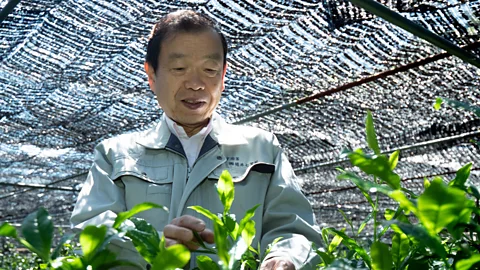 Hiromi Tanoue
Hiromi TanoueIt’s thanks to this plant that we produce some of the highest-grade matcha in the world,” Horii said.
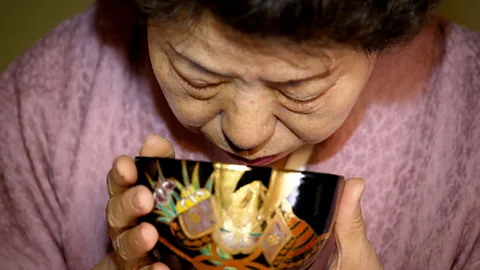 Hiromi Tanoue
Hiromi TanoueThe process of growing the tea is at once simple and extremely complex. On one hand, tea trees are relatively self-sustaining, relying on sunlight and, most typically, just the amount of rain nature provides. But to make sure the matcha is of the highest grade – the kind the most discerning of matcha connoisseurs and buyers will demand – farmers must provide an extra level of care.
Every farm has a different, secret mixture of nutrition for their plants. For Horii, that includes palm tree oil and bits of fish from Kyoto. Back in the day, most also used human excrement to make sure the soil was richly fertilised, but “we don’t do that anymore,” he said with a laugh.
Farmers prepare ceremonial-grade batches especially for matcha competitions, where judges conduct blind-taste tests, give out awards and purchase tea leaves. For Horii, the oldest plants are the most prized, as they grow matcha that has a stronger taste, smell and colour – which is what the judges look for and makes the tea extremely valuable.
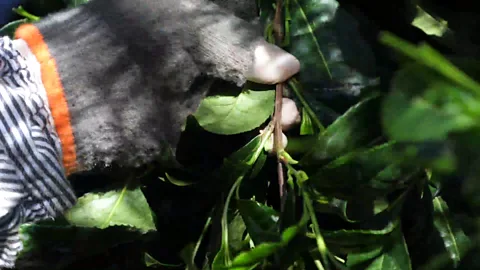 Hiromi Tanoue
Hiromi TanoueWhen spring comes, Horii begins monitoring the plants closely, every day, to evaluate how they’re doing. Timing is everything: they must be covered and picked at exactly the right time for optimal flavour.
The tea leaves in Uji are harvested by hand only once a year; in other parts of the country producing lesser-quality matcha, this is done two or three times and by machine in order to get more quantity.
In Uji, the leaves are still picked by hand by seasoned workers. They take the new leaves and leave the old leaves to sell in their shops and the matcha competitions. Despite ‘Uji tea’ being d throughout Japan, in the US and online, consumers can really only be guaranteed the high-quality, ceremonial grade tea from Uji by visiting a farm’s shop.
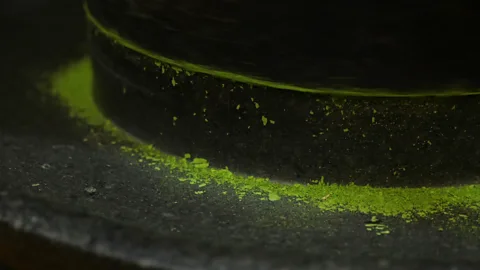 Hiromi Tanoue
Hiromi TanoueThe entire process of growing matcha requires patience and careful attention, and the grinding of the tea leaves is no different. While matcha is powdered green tea, not all powdered green tea is matcha. What makes the tea matcha is that the leaves are first turned to tencha through a process of de-stemming and de-veining in preparation for them to be dried and pulverised. Once picked, the whole leaves are brought to a tea-processing facility, steamed, and then let to cool down before being dried on a conveyor belt that runs through a brick oven called hoiro.
Producers then use the ancient process of grinding the dried tencha tea leaves with an ishi-usu, or stone mill, the same method brought over in the 12th Century by Buddhist monk Eisai. The stone mills, designed with teeth that grind slowly in a counter-clockwise rotation, allow for a very fine, even powder.
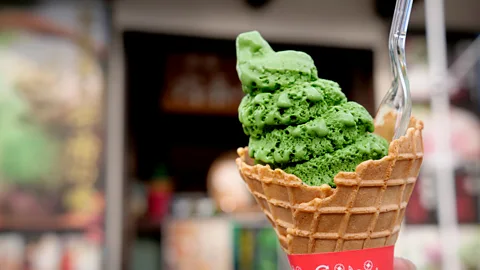 Hiromi Tanoue
Hiromi TanoueMatcha has many health benefits. It’s incredibly high in antioxidants, including EGCG, and is thought to boost metabolism, in turn increasing energy expenditure to burn calories, detoxify the body, calm the mind, elevate mood and concentration, and boost energy without giving you the same crashing feeling that coffee does. All these benefits have skyrocketed the drink to the top of health and wellness trends in recent years. The bold green colour has also made matcha a star of Instagram, included in everything from lattes to pastries to ice cream.
According to a report published by Analytical Research Cognizance, matcha sales in the United States have increased five-fold to more than $10 billion in the last 25 years. The global demand, however, hasn’t been for the high-quality tea made in Uji. Instead, it’s mainly been for cheap, low-quality matcha used to mix in baked goods or frothy drinks. The trend is similar in Japan, where younger people are also enjoying a more modern take on matcha.
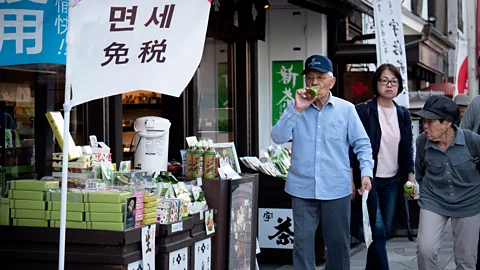 Hiromi Tanoue
Hiromi TanoueFarms have popped up in various Japanese regions outside of Uji, like Kagoshima, to meet this demand for lower-quality matcha. While they still use the shade-grown technique, these other regions produce large volumes picked with machines and conduct second and even third harvests of the plants each year.
Because the lower-quality matcha is where the money is, the farmers crafting high-quality matcha have become even more rare. In Uji, only 60 farming families are left growing the tea.
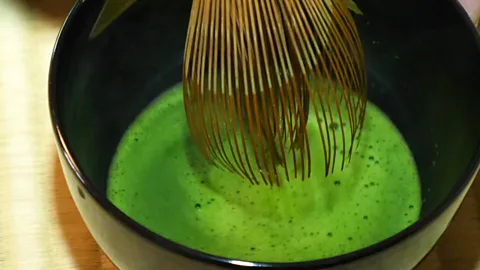 Hiromi Tanoue
Hiromi TanoueUji farmers hope the centuries-old tradition of growing and consuming matcha isn’t lost among the more modern craze.
Preparing the perfect cup is an art form worth preserving: after placing a tablespoon or two of matcha in with hot water (just under a boil), a matcha whisk is used in a vigorous back-and-forth, zig zag motion so the bubbles form a perfect froth. The result should be a strong smell, a vibrant green colour and a startlingly rich umami flavour that is bold yet incredibly smooth – a cherished flavour for centuries.
(Text by Clara Hogan; video by Hiromi Tanoue)
The World’s Rarest is a BBC Travel series that introduces you to unparalleled treasures found in striking places all across the world.
